It is difficult to choose the 5 greatest cathedrals in France, but those listed here seem to me to be the most impressive. Whatever your views, there’s no denying the significance of cathedrals in France. To believers, a cathedral is a sacred, holy place of worship. Others may see a treasure house of fabulous art, a symbol of oppression and ostentatious wealth, or simply another historic monument.
A Catholic cathedral is the center of a diocese and bishop’s seat (that’s what makes it different from a church), and so it tends to be big and ornate, illustrating God’s glory and the Church’s power. All these that I have listed are dedicated to Notre Dame (the mother of Jesus) and all but one are free to enter, with fees charged to ascend the towers.
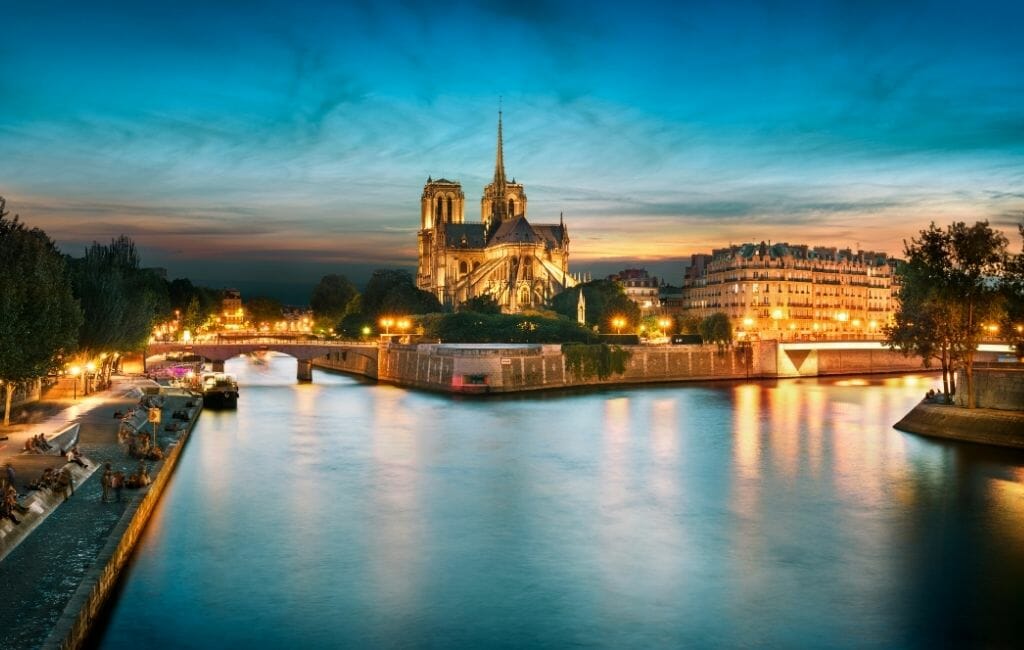
Greatest Cathedrals in France
Notre Dame de Paris
As we all know, the stunning cathedral burned down on April 15, 2019. It is currently closed for visitors and is scheduled to reopen in December 2024. Stay tuned for updates!
This Gothic cathedral in the heart of Paris is the most visited monument in France, with 13 million visitors a year. With construction beginning in 1163, it was finally completed about 1345, and there have been a good many renovations since then. In 1793, anti-religious revolutionaries destroyed sculptures and treasures and dedicated the building to the Cult of Reason, with Lady Liberty replacing the Virgin Mary. A few years later, a builder planned to demolish it and use the stones for housing.
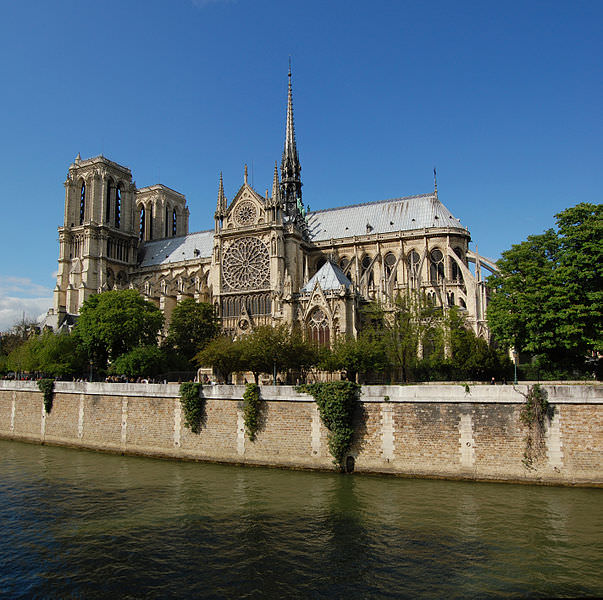
Napoleon Bonaparte saved it and had himself crowned emperor there, but it was the author Victor Hugo who created real interest in restoration. His 1831 novel The Hunchback of Notre Dame (in French, Notre Dame de Paris), sparked a public demand, and full restoration began in 1845. In recent times, between 1991 and 2001, further work preserved and cleaned the historic architecture and colors.
Notre Dame de Paris, now owned by the state and a World Heritage Site, is 128 meters (420 feet) long, with two towers 69 meters (226 feet) high, and a spire. Several rose windows glow with exquisite medieval stained glass; one was the biggest window in the world when it was made.
There’s a lot to admire here: statues of ancient kings of Israel, the famous flying buttresses and gargoyles, the intricate carvings, and the 28,000-pound bell. The cathedral is not only a tourist attraction, it’s an active church with Mass, chanting, and music performed on a regular basis. It’s a dazzling sight any time of day, and at night it glows under colored lights.
Cathédrale Notre-Dame de Chartres
One of the greatest Gothic cathedrals in France stands in Chartres, a pretty town on the Eure River in the Loire Valley. Chartres is only an hour by train or car from Paris, and many visitors make it a day trip — ride through the countryside, tour the cathedral, have lunch, ride back — and some wonder why all the fuss over one more medieval stone church with soaring spires, flying buttresses, and stained glass windows.

The awe-inspiring cathedral in Chartres, southwest of Paris, was constructed between 1193 and 1250. It was the first to use flying buttresses and is considered to be one of the finest examples of French High Gothic architecture, among other claims to fame. The cathedral is very well preserved; most of the original stained glass windows are intact, and there have been only minor changes to the architecture since the early 13th century.
The Chartres cathedral is worth a visit for the stained glass windows alone. They are magical – 2500 square meters of scenes made from bits of vividly colored glass. And there’s more: two spires of different styles, hundreds of sculpted figures, soaring arches, a relic of the Virgin Mary’s tunic, and a labyrinth set in the floor of the nave. If you want to walk the labyrinth, come on a Friday, the only day the chairs are cleared away. Hours: 8:30 a.m. – 7:30 p.m. daily.
Having spent time in Chartres studying the cathedral and its history, walking the labyrinth, and exploring the town, I’ve learned that this UNESCO World Heritage Site is an extraordinary place, worth much more than a quick look.
Built in the 12th and 13th centuries, the cathedral is the sixth Christian place of worship to stand on this hill, and even earlier it was a place of spiritual ceremony for Druids. You can still see their ancient well, deep in the crypt. It’s been sacred ground for a long time.
In 1194, the previous church burned to the ground, and when people heard that a treasured relic of the Virgin Mary’s veil miraculously survived the fire, they were determined to build a magnificent cathedral in her honor. Nobles, royalty, and laborers alike gave gifts, money, and skills, and in 25 years the work was almost completed. Changes in style continued over time, such as the tallest, most intricate spire, done in the 16th century.
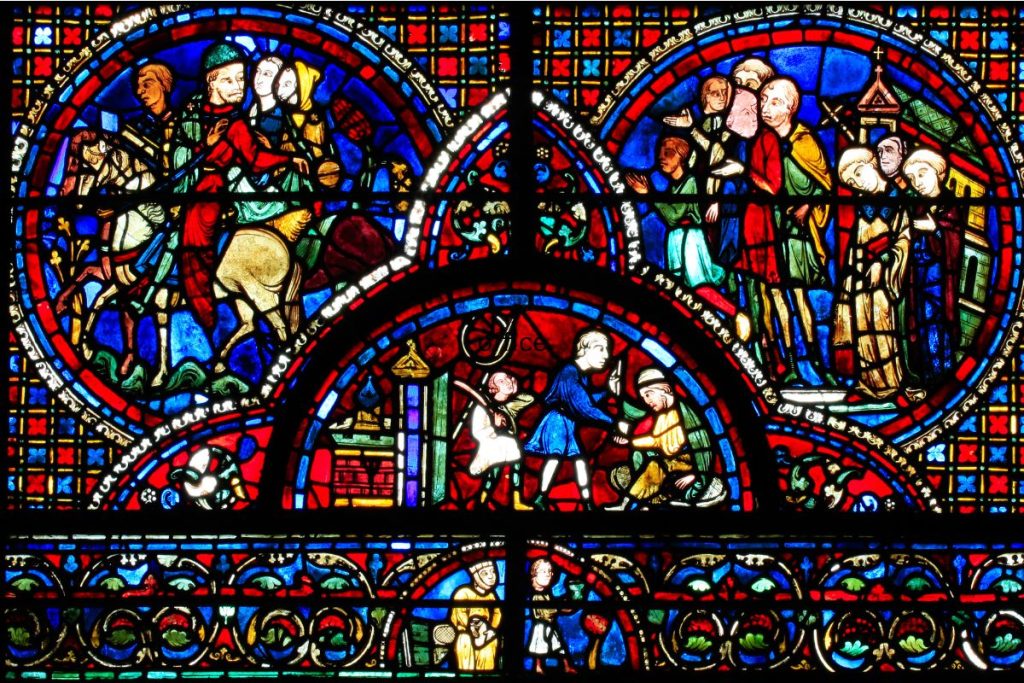
When you pass through the huge doors, with their richly sculpted arches, and enter the dim, vaulted interior, you see 167 stained glass windows that glow like jewels. As the custodian Etienne Houvet said in the foreword to his guide, it’s as if you were “clad in a garment of gems.” The light and coloring change with the season and hour, and the impression is magical. Most windows show a biblical or saint’s story; a few depict French royalty and one has the signs of the zodiac. To learn more about how the multi-colored stained glass was made, and perhaps purchase a piece, visit the nearby Gallerie du Vitrail.
There are numerous carvings, screens, and sculptures throughout the cathedral. The Cathedral of Chartres is also home to two Black Madonnas.
On the floor, in the center of the nave, is the famous labyrinth (not a maze). Its well-worn stones are usually covered by chairs, but if you go on a Friday or an early morning you have a good chance of walking the 11 circuits. In medieval days the devout crawled the labyrinth on their knees, representing a pilgrimage to Jerusalem. Today’s pilgrims walk as a meditation, circling toward the center and out again.
A guided tour is the best way to fully experience this unique place. Malcolm Miller is a recommended expert guide who can explain, in English, every aspect of the cathedral and its history. It’s guaranteed to help you see medieval art and beliefs in new ways.
Photos are © by the Chartres Convention and Visitors Bureau
Cathédrale Notre-Dame d’Amiens
This classic Gothic cathedral, in Picardy, is the largest in France of its kind. It’s a stunning piece of 13th-century architecture, very long and narrow, with slim pillars in an elegant nave that reaches as high as 42.3 meters (139 feet) and a width of 14.6 meters (48 feet). Open arcades and large windows give the interior an unusually light, airy feel and among the various designs in the floor is an angled labyrinth, a modern copy of the 1288 original. Elaborate is the word for the exterior, which swarms with intricate carvings and arches.
The cathedral was built as a shrine for the head of John the Baptist, which was, they say, brought back from the Crusades. Wars destroyed part of this important place of pilgrimage, but it has been restored, and in 2000, the three west front portals were cleaned with a laser method that revealed traces of the original paint on the sculptures. Every night in summer, a sound and light show presents colorful views of the cathedral, its towers, and huge rose window. At the 10:15 a.m. Sunday Mass, Gregorian chants add to the atmosphere. Hours: Easter to October, 8:30 a.m. – 6:45 p.m.; November to Easter, 8:30 a.m. – 5:15 p.m.
Cathédrale Notre-Dame de Reims

Here’s a cathedral with a long history. Every French king between 815 and 1825 was crowned on this site in the province of Champagne, and one of France’s first Christian bishops, St. Rémi, baptized Clovis, king of the Franks, here in 496. The present building, replacing one that burned in 1211, was completed in the late 13th century, with some later additions. The façade is considered a medieval masterpiece. Dozens of sculptures, outside and in, decorate the cathedral. There’s a profusion of Biblical figures, angels, and bishops, and French kings from Clovis on are carved in the gallery of the kings.
The rose window and the collection of tapestries are considered among the finest in France. With paintings by Tintoretto and Nicolas Poussin, stained glass by Marc Chagall, and beautifully carved woodwork, it’s like touring a museum full of great art. The cathedral was heavily damaged by bombings during World War I and restored partially by post-war American contributions. It was here, in 1945, that General Eisenhower and the Allies accepted the surrender of the German army, ending World War II. Hours: 7:30 a.m. – 7:30 p.m. daily.
Cathédrale Notre-Dame de Rouen
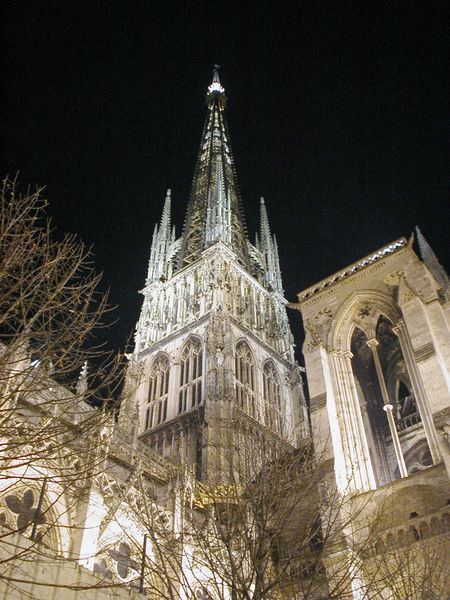
The Rouen cathedral has a familiar look to anyone who has seen Claude Monet’s paintings of it, which are now in various museums (Musée d’Orsay in Paris, National Gallery of Art in Washington, D.C., the Getty Center in Los Angeles, among others). Between 1892 and 1894, Monet painted more than 30 canvases of the cathedral façade in impressionistic style and different lights.
The cathedral, built and rebuilt since its consecration in 1063, reflects the changing styles of the centuries: Early, High and Late Gothic, Flamboyant Gothic, Renaissance, and more combine to make a three-towered building covered with intricate, lacy stonework. The Lantern Tower, built in 1876 and 500 feet high, holds 56 bells. The Rouen cathedral has been renowned since the Middle Ages for its music, with a fine organ and a noted choir and choir school. The tall, arched, stained glass windows from the Renaissance are lovely. This cathedral holds some noted burials, including the heart of Richard the Lionhearted. The tomb of John Lancaster, Duke of Bedford, was here until it was destroyed by Calvinists–perhaps they disapproved of the duke as the man responsible for killing Joan of Arc. Today he’s commemorated with a plaque. Hours: Monday, 2:00 p.m. – 6:00 p.m., Tuesday-Saturday 7:15 a.m. – 7:00 p.m., Sunday 8:00 a.m. – 6:00 p.m.
What are your favorite Cathedrals in France?
Remember to book some fun activities and tours for your trip to France in advance!
Greatest Cathedrals in France – Written by Marilyn McFarlane for EuropeUpClose.com



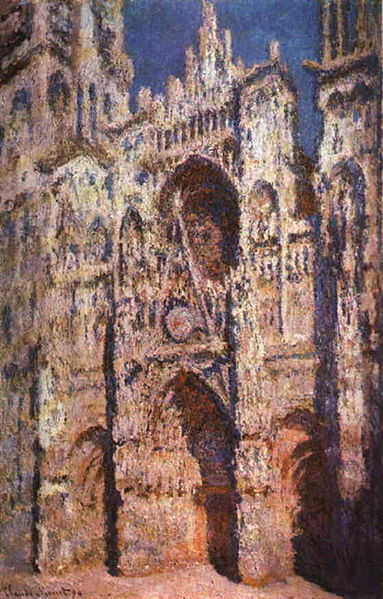
Hugh
Thursday 1st of January 2015
I visited Chartres earlier this year while staying in Paris. The cathedral is certainly fine with the stained glass an outstanding feature. However, there are other churches in the city and one of them, St. Pierre, is breathtaking too with beautiful Gothic architecture and stained glass. Do try to visit this church since it is an ideal complement to the glories of the cathedral.
Feily
Friday 25th of November 2011
Just want to add a little... you can walk Chartres Labyrinth on Friday of October (according to the latest schedule from Rectorat de la Cathedrale).
Marilyn
Thursday 4th of August 2011
Mark, your experience is a good reminder that there's always more to learn. Many faiths use similar prayer beads to count the number of times a prayer has been recited. By the way, the largest rosary collection in the world (4,000) is tucked away in the Columbia Gorge Interpretive Center Museum, in Stevenson, Washington. The Dan Brown Rosary Collection is impressive.
Mark S
Wednesday 3rd of August 2011
This is a funny story but true. Went to Notre Dame in Paris and while there I looked at the rosaries they had there for sale.I looked at many of them planning to buy one for my mom but was thinking, was Notre Dame a catholic church. Because I had been to so many churches on this trip and know many were not catholic but still had Jesus on the cross over the alter I didn't know so I didn't buy a rosary. When I got home a friend of mine told me that only catholic churches had rosaries. I was raised catholic and the entire time going to catholic school was the fact that only catholic churches used rosaries brought up. I was in deep water for a couple years until I went to Rome and bought her a rosary from the Vatican.
Terri Fogarty
Wednesday 3rd of August 2011
great story!
Sailor
Thursday 28th of July 2011
Beautiful Pictures. I like the second one most, the Notre Dame de Paris.